How Often to Rotate Tires? Guide for FWD, RWD, and AWD Cars
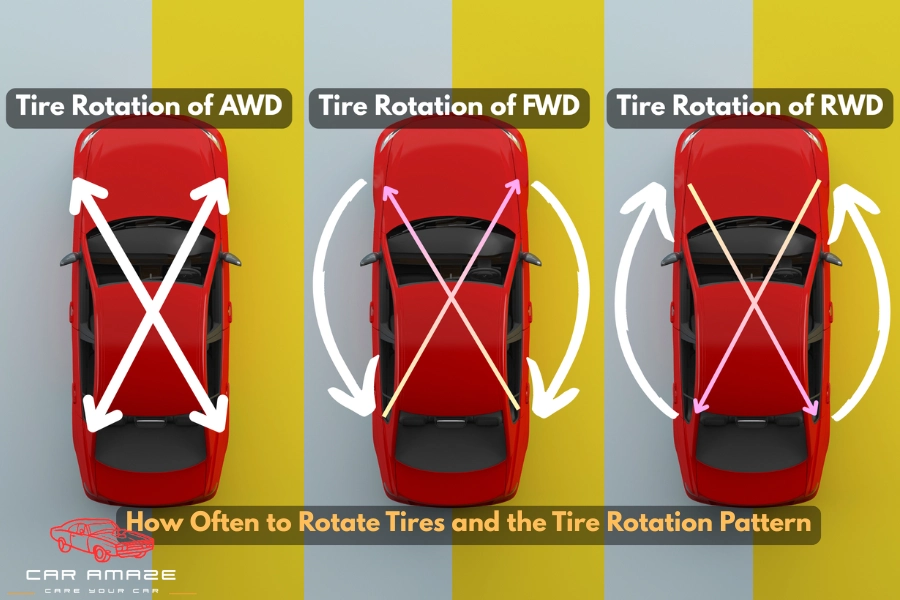
When you drive the car, the tires start wearing out, especially the front tires. Tire rotation is the way to deal with this situation. But the thing to understand is how often to rotate tires and how to do it. I have prepared this guide to help you understand what tire rotation is, when it is needed, how often to do tire rotation, what affects tire condition, and more easy DIY tips. Let’s discuss everything step by step:
Quick Overview: How Often to Rotate Tires and Tire Rotation Pattern 📄
For FWD and RWD cars, you should rotate your tires every 5,000 to 7,500 miles to help them wear evenly and last longer. In comparison, rotate tires every 3,000 to 5,000 miles for AWD cars.
- For FWD cars, move the rear tires to the front and switch sides, and move the front tires straight to the back without switching sides.
- For RWD cars, move the front tires to the back and switch sides, and move the rear tires straight to the front without switching sides.
- For AWD cars, use a crisscross pattern and swap the front and back tires on opposite sides.
Table of contents
- Why Is Tire Rotation Necessary?
- How Often to Rotate Tires of FWD, RWD, and AWD Cars
- Signs Your Tires Need to Be Rotated Sooner
- How to Rotate Tires at Home (DIY Guide)
- Factors That Affect How Often You Should Rotate Tires and Tips
- What Happens If You Don’t Rotate Your Tires?
- Tire Rotation vs. Wheel Alignment: What Is the Difference?
- Conclusion
- FAQs
Why Is Tire Rotation Necessary?
When a car drives on a road, all tires do not get used exactly the same way. On some tires, cars put more force, and they wear quickly, while on others, they put less force. Tire rotation is the only option for utilizing the tires for a longer duration. Here is the overview of how car tires get damaged over time:
- On many cars, the front tires work harder because they steer and brake.
- On front-wheel drive (FWD) cars, the front tires also bear the power of the engine.
- On rear-wheel drive (RWD) cars, the back tires face the engine power.
- On all-wheel drive (AWD) cars, all four tires share the work.
So, the car tires wear unevenly, but you can avoid this through tire rotation. Tires need to be rotated because:
- All tires will wear evenly at about the same rate.
- Your tires last longer.
- The traction (grip on the road) stays strong.
- Car rides stay smoother and safer.
- Help you save money due to the feverish need for tire replacement
Now that you understand why tire rotation is important, let’s focus on the main question: how often to rotate tires.
How Often to Rotate Tires of FWD, RWD, and AWD Cars
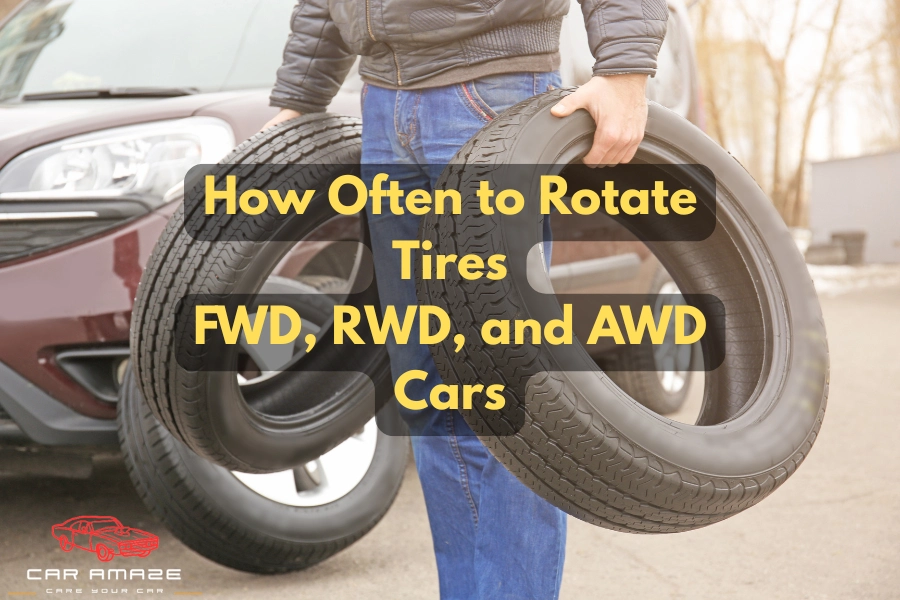
Let’s come to the main part: how often to rotate tires. It actually depends on the type of car and driving style. Let’s break it down:
Tire Rotation for FWD (Front-Wheel Drive) & RWD (Rear-Wheel Drive)
If you have an FWD or RWD car, the recommended mileage to rotate tires is 5,000 to 7,500 miles. If your driving style is bad, the tire condition can get worse even before 5,000 miles. That is why you should always keep a check on the tires’ condition and do tire rotation on time.
Tire Rotation for AWD (All-Wheel Drive)
In the AWD car, all four tires share the power. Due to this reason, the tires wear out more quickly in AWD cars. So, the recommended interval to do tire rotation can be 3,000 to 5,000 miles.
Quick Reference Table for Tire Rotation Interval
Here is the quick overview of how often to rotate tires:
| Drive Type | Suggested Interval | Notes |
| FWD / RWD | ~5,000-7,500 miles | Check manual |
| AWD | ~3,000-5,000 miles | More frequent |
| Less driving / smooth roads | Maybe longer | But inspect anyway |
Signs Your Tires Need to Be Rotated Sooner
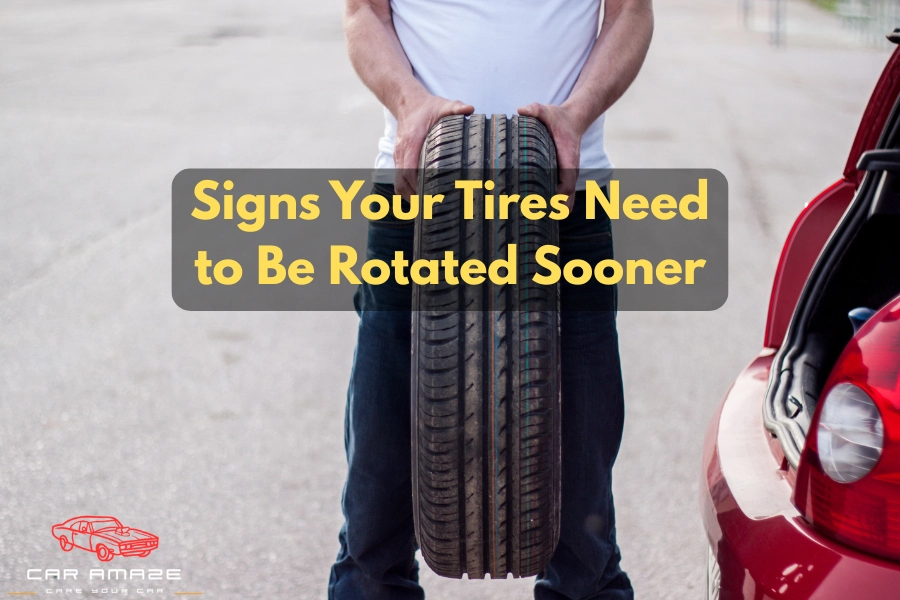
Do not just keep track of the mileage of your car for tire rotation. There are some signs that indicate the need for tire rotation. And these signs may appear before reaching the mileage limit to do a tire rotation. Here are some important signs:
- Uneven or bald tread: One tire is much more worn than the others.
- Steering wheel vibration: The car shakes when you drive smoothly.
- Car pulls to one side: You steer straight, but your car veers.
- Tire pressure drops frequently: This could mean a weak tire or wear.
- Fuel efficiency drops: Worn tires = more engine work = more fuel.
If you see any of those, rotate the tires before reaching the mileage limit.
How to Rotate Tires at Home (DIY Guide)
Rotating the car tires is possible at home if you have the required tools and know the right steps. I am sharing the step-by-step process to rotate your car’s tires.
Tools You Will Need to Rotate Tires:
- Jack and Jack stand
- Lug nut wrench
- Tire pressure gauge
- Chalk or marker (to mark tires)
- Optional: torque wrench
Steps to Do Tire Rotation:
Here are the easy steps to rotate your car’s tires:
- Park on a flat surface and set the parking brake.
- Loosen the lug nuts slightly (don’t remove yet).
- Jack up one wheel and place a jack stand under the car.
- Remove the tire.
- Air each tire to the proper pressure (check the sidewall for the number).
- Move each tire according to your car type, such as FWD, RWD, or AWD.
Tire Rotation Pattern for FWD, RWD, and AWD
1. FWD (Front Wheel Drive)
If you are rotating the tires of an FWD car, move the rear tires to the front and switch sides. Next, move the front tires to the back on the same side.
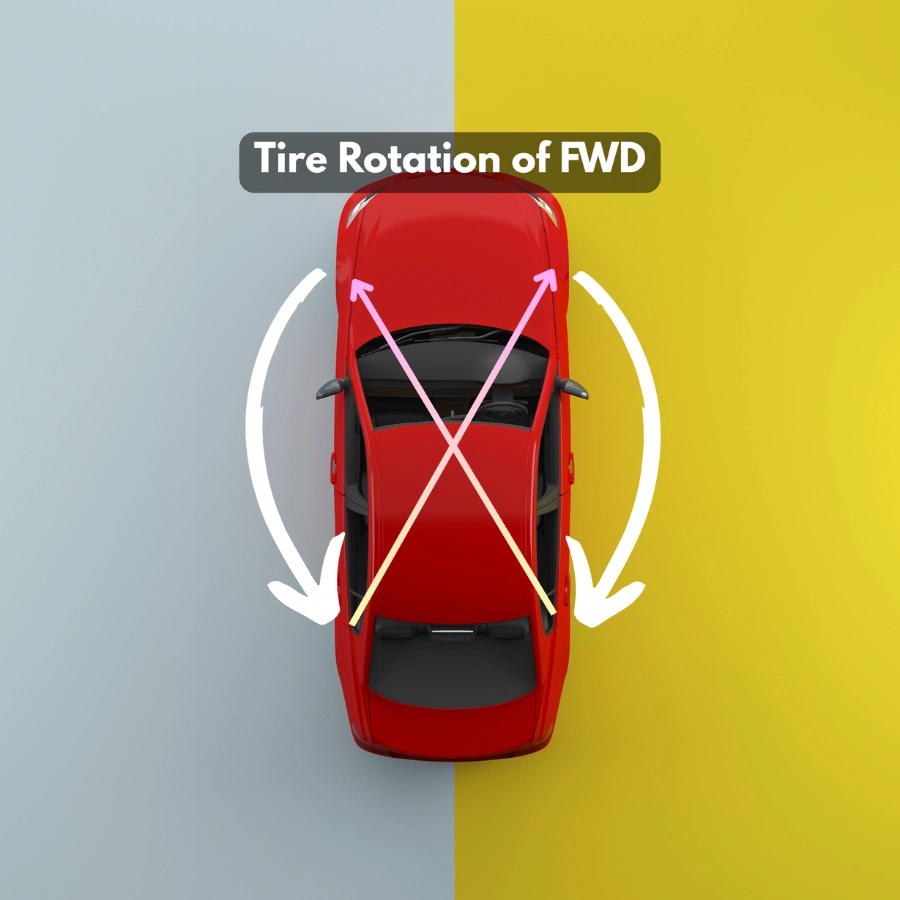
2. RWD (Rear Wheel Drive)
If the car is with rear wheel drive, do the opposite of FWD. First, move the front tires to the back and switch sides. Next, move the rear tires to the front without switching sides.
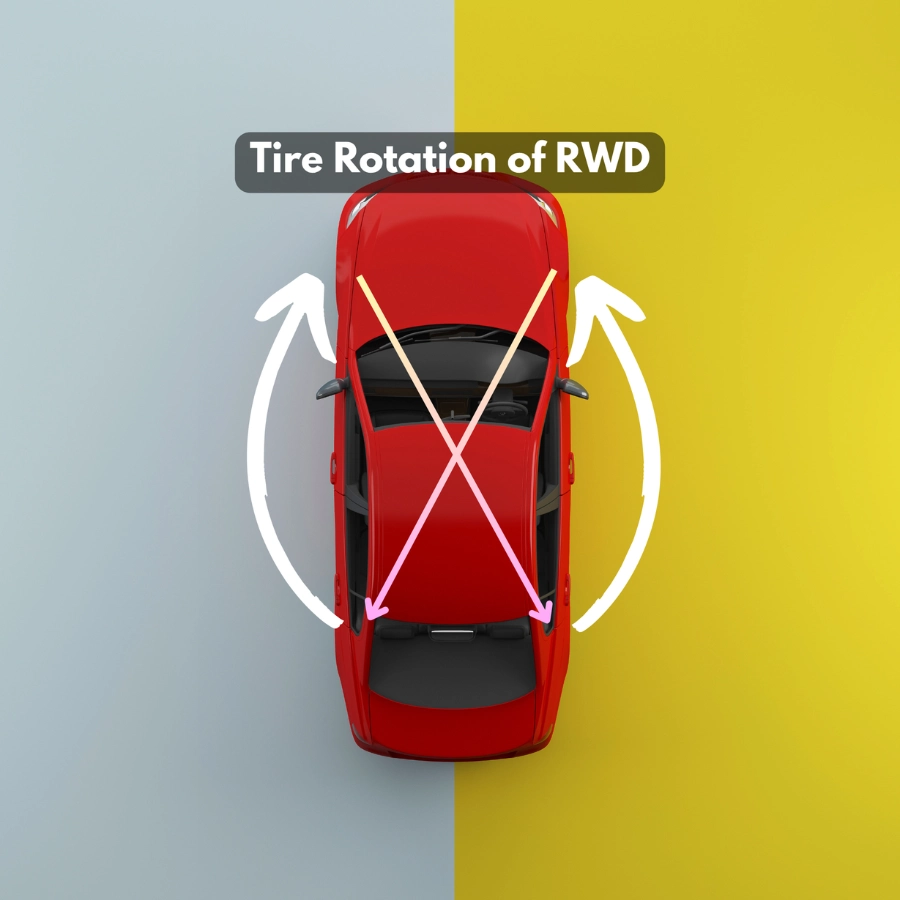
3. AWD (All-Wheel Drive)
The tire rotation pattern for AWD is different from FWD and RWD. You will move the front tire to the rear by switching sides, and the rear tires to the front tires by switching sides. Here is the overview:
- Left Rear → Right Front
- Right Rear → Left Front
- Right Front → Left Rear
- Left Front → Right Rear
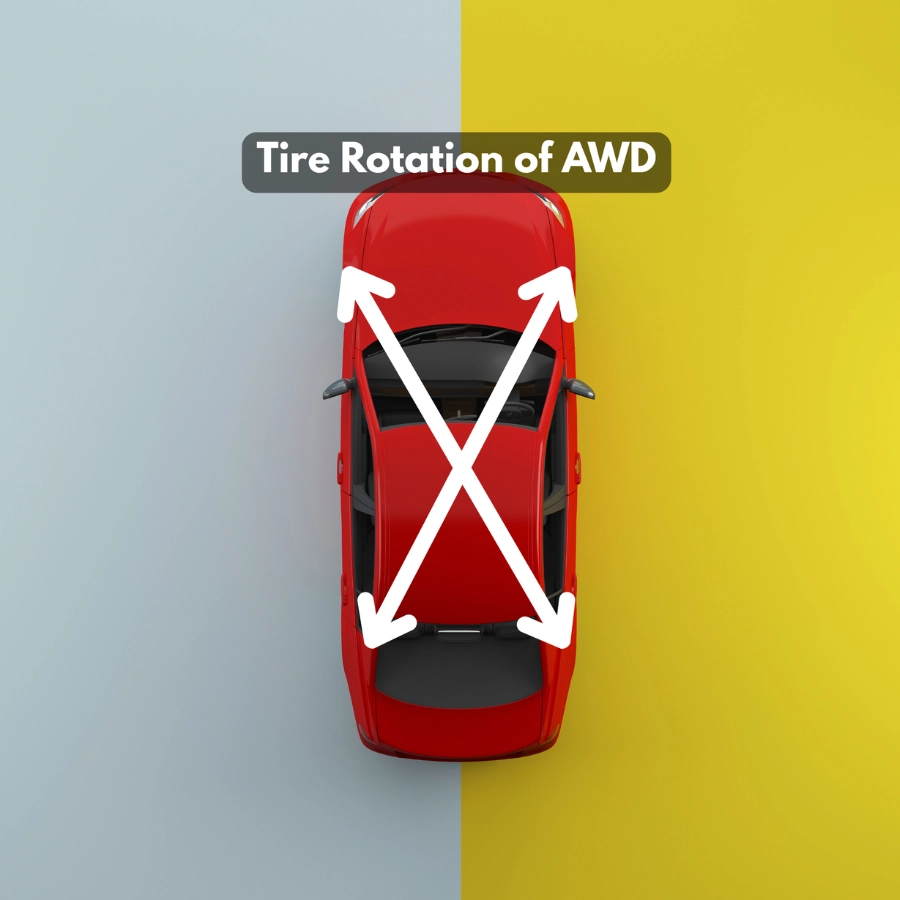
After rotating the tires in the right pattern, tighten the lug nuts by hand first, then lower the car, then tighten fully in a star pattern. Finally, check the tire pressure and reset your TPMS if necessary. So, as you see, with some easy steps, you can rotate tires on your own.
Factors That Affect How Often You Should Rotate Tires and Tips
There are many factors that affect the lifespan of a tire and the time to rotate the tires. Here is the list of those factors:
- Driving habits: Rough driving or heavy braking wears tires faster.
- Road conditions: Rough roads, potholes, and gravel damage the tire more.
- Tire type: Some tires that are built for performance or low-profile may wear faster.
- Vehicle load: Carrying heavy loads or towing makes tires work harder.
- Wheel alignment & tire pressure: If alignment is off or brakes are hard, wear is uneven.
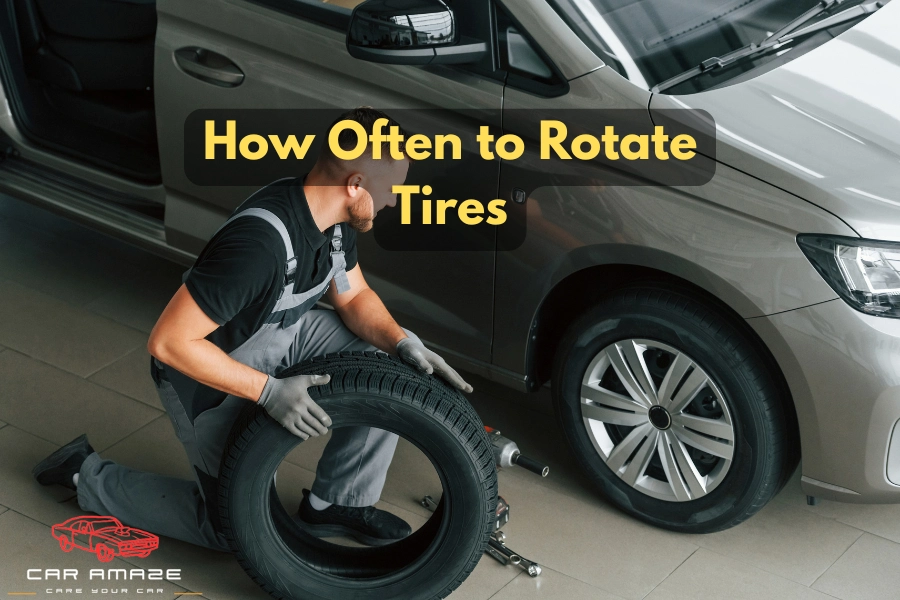
But do not worry; with some precautions, you can keep tires in good condition for a long time.
Expert Tips to Make Your Tires Last Longer
Here are some extra tips to increase the lifespan of tires, and the tires will run more miles before requiring rotation:
- Check tire pressure monthly because underinflation causes faster wear.
- Make sure that the tires are properly balanced to avoid vibration and uneven wear.
- Align wheels every 1-2 years.
- When tread gets low (e.g., 4/32″), it’s time to think about new tires.
- Drive smoothly and avoid hard braking and fast cornering.
What Happens If You Don’t Rotate Your Tires?
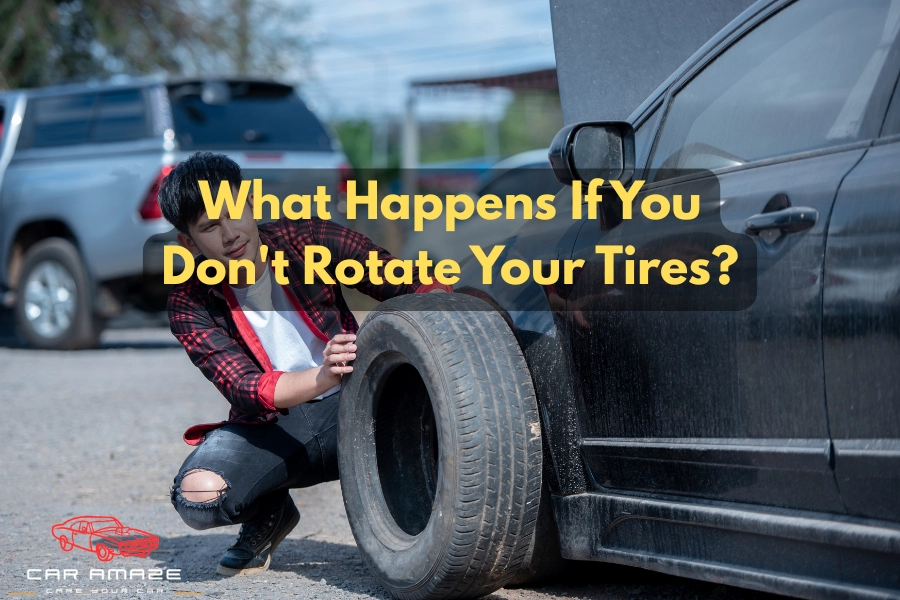
When the time is for tire rotation, never skip it. Skipping or delaying tire rotation can lead to bad outcomes, which are listed below:
- Shorter tire life: They wear out unevenly and faster, which reduces the average lifespan of a tire.
- Poor braking or loss of traction: Uneven wear affects grip on the road and can cause serious accidents.
- Higher risk of blowouts: Thin spots can fail under stress and result in tire bursts.
- Suspension or alignment damage: Uneven tires put heavy strain on the suspension.
- Need for replacement: Delaying the tire rotation can result in permanent damage. In that case, you will have to spend money on a new tire.
Cost and Time to Do Tire Rotation
Tire rotation is not an expensive procedure. On average, many tire shops charge just $20 to $50 for rotating the tires of your car. Additionally, tire rotation of the vehicle is also a very quick task. It takes around 30 minutes to an hour to rotate all the tires of your car.
Tire Rotation vs. Wheel Alignment: What Is the Difference?
Some people mix tire rotation with wheel alignment, but actually, both these terms are different. Tire rotation means moving tires to different positions to even out the wearing process. On the other hand, wheel alignment means adjusting the angles of wheels so that the car turns correctly and tires wear evenly.
Conclusion
In short, aim to do tire rotation every 5,000 to 7,500 miles for RWD and FWD and 3,000 to 5,000 miles for AWD vehicles. Make sure you rotate the tire correctly based on the rotation pattern discussed above in this guide. Rotating the tires on time helps you save money, stay safe, enjoy a smooth ride, and increase the lifespan of the tires.
FAQs
Can I rotate my tires every oil change?
Yes, you can rotate tires on every oil change because usually oil changes happen around 5,000 miles.
Do all cars need tire rotation?
Yes, almost every car needs tire rotation. But some high-performance cars have tires that cannot be rotated because of size or direction.
What is the best tire rotation pattern?
It depends on the type (FWD, RWD, AWD). Use the patterns above in this article.
Does the position of the car engine in front or back affect tire rotation?
Whether your car has an engine in the back or in the front, it will not affect rotation. The primary factor is the type of drivetrain (FWD, RWD, or AWD) that influences rotation patterns and intervals.
Is tire rotation necessary if I have new tires?
Yes. Even new tires benefit from rotation because they will wear when new, just like older tires.
How often should I rotate tires if I drive very little?
If you drive fewer miles and with care, you can extend the interval of tire rotation to around 8,000 miles. But most tire experts still recommend rotating tires at least every 6 months, regardless of mileage.







